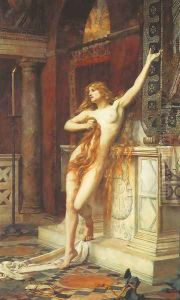Charles William Mitchell Paintings
Charles William Mitchell was an English pre-Raphaelite painter, born in Newcastle upon Tyne in 1854. Despite his relatively short life, Mitchell left a notable mark on the Victorian art scene, particularly through his work that often explored mythological and biblical themes with a distinctive pre-Raphaelite aesthetic. Mitchell's artistic journey was deeply influenced by the broader pre-Raphaelite movement, which sought to reject the mechanistic approach to art that had been prevalent during the Industrial Revolution, instead emphasizing detailed observation and a return to the complex compositions and vibrant colors of Quattrocento Italian art.
Mitchell studied at the Newcastle School of Art and later, the Royal Academy Schools in London, where he honed his skills and developed his unique style. His work is characterized by its meticulous attention to detail, vibrant color palette, and the often ethereal quality of its figures. One of Mitchell's most famous works, 'Hypatia' (1885), exemplifies his ability to blend classical themes with a pre-Raphaelite sensibility. The painting depicts Hypatia, the mathematician and philosopher of Alexandria, as a martyr, surrounded by a mob that is about to murder her. This work, with its dramatic intensity and historical subject matter, showcases Mitchell's skill in narrative painting and his interest in themes of innocence and tragedy.
Despite his talent, Charles William Mitchell did not achieve widespread recognition during his lifetime, perhaps overshadowed by more prominent figures in the pre-Raphaelite movement such as Dante Gabriel Rossetti, John Everett Millais, and William Holman Hunt. Nevertheless, his work has been reassessed in recent years, with art historians and critics acknowledging his contribution to the late Victorian art scene. Mitchell's paintings are now appreciated not only for their beauty and technical skill but also for their emotional depth and complexity.
Tragically, Mitchell's career was cut short when he died in 1903 at the age of 49. Although his oeuvre is not extensive, the quality and distinctive style of his work have secured his place in the history of British art. Today, Mitchell's paintings can be found in various collections, including public galleries in the UK, where they continue to be studied and admired for their intricate detail, rich coloration, and profound emotional resonance. Charles William Mitchell's legacy, though once nearly forgotten, endures as a testament to the enduring appeal and relevance of the pre-Raphaelite movement.
